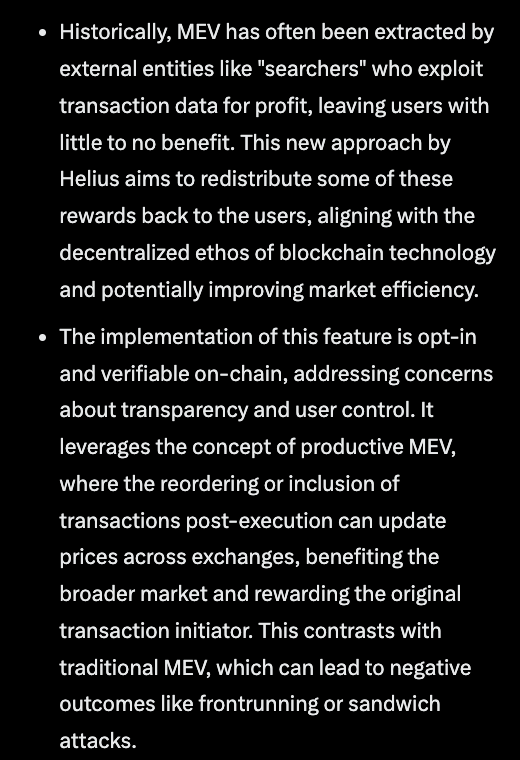big new release
earn SOL for your transactions!
TL;DR — we help you capture the rewards that your txns generate
important: this is *completely optional* — we only do this if you opt-in
How does it work?
i) you send a txn (buy/sell/swap)
ii) searchers look at a stripped down version of the txn (the searchers are KYC'd + txn has no signature so they can not frontrun or sandwich)
iii) **after your trade executes**, if it generates an arbitrage opportunity—most commonly: updating prices across exchanges—you earn 50% of the rewards!
that's it, no additional malicious MEV risk
there's a lot of misinformation and lack of understanding when it comes to this, so to be clear:
i) this does not affect the user's trade, an arbitrage happens only after the user's trade goes through (unlike other forms of MEV, this is considered "productive MEV" since it helps update prices for users)
ii) this is completely opt-in and will only happen if the developer explicitly commands to do it
iii) this is all verifiable onchain!
iv) this already happens across many venues and ecosystems, and this is one of the first ways where the user/app actually now gets to earn their own rewards!
enjoy!
earn SOL for your transactions!
TL;DR — we help you capture the rewards that your txns generate
important: this is *completely optional* — we only do this if you opt-in
How does it work?
i) you send a txn (buy/sell/swap)
ii) searchers look at a stripped down version of the txn (the searchers are KYC'd + txn has no signature so they can not frontrun or sandwich)
iii) **after your trade executes**, if it generates an arbitrage opportunity—most commonly: updating prices across exchanges—you earn 50% of the rewards!
that's it, no additional malicious MEV risk
there's a lot of misinformation and lack of understanding when it comes to this, so to be clear:
i) this does not affect the user's trade, an arbitrage happens only after the user's trade goes through (unlike other forms of MEV, this is considered "productive MEV" since it helps update prices for users)
ii) this is completely opt-in and will only happen if the developer explicitly commands to do it
iii) this is all verifiable onchain!
iv) this already happens across many venues and ecosystems, and this is one of the first ways where the user/app actually now gets to earn their own rewards!
enjoy!
read the docs for more details here: helius.dev/docs/sending-t…
quick explainer from grok
TL;DR — you should be able to earn the rewards that your txns create instead of being cut out
better prices -> better markets
TL;DR — you should be able to earn the rewards that your txns create instead of being cut out
better prices -> better markets

• • •
Missing some Tweet in this thread? You can try to
force a refresh









